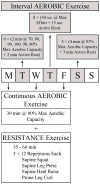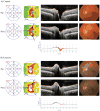Ophthalmological Evaluation of Integrated Resistance and Aerobic Training During 70-Day Bed Rest
- PMID: 28641680
- PMCID: PMC5568005
- DOI: 10.3357/AMHP.4768.2017
Ophthalmological Evaluation of Integrated Resistance and Aerobic Training During 70-Day Bed Rest
Abstract
Introduction: We evaluated ophthalmic changes in healthy individuals who underwent integrated resistance and aerobic training (iRAT) during 70-d 6° head-down tilt (HDT) bed rest (BR).
Methods: Participants were selected using NASA standard screening procedures. Standardized NASA BR conditions were implemented. Subjects were randomly assigned to the iRAT protocol or no exercise during HDTBR. Weekly ophthalmic examinations were performed in the sitting (pre/post-BR only) and HDT (BR only) positions. Mixed-effects linear models compared pre- and post-HDTBR intraocular pressure (IOP), Spectralis OCT circumpapillary retinal nerve fiber layer (cpRNFL) thickness, and peripapillary retinal thickness observations between groups.
Results: Six controls and nine exercisers completed the study. There was an overall effect of BR on our outcomes. Except Goldmann IOP (mean pre/post difference in controls and exercisers: -0.47 mmHg vs. +1.14 mmHg), the magnitude of changes from baseline was not significantly different between groups. There was a +1.38 mmHg and a +1.63 mmHg iCare IOP increase during BR in controls and exercisers, respectively. Spectralis OCT detected a +1.33 μm average cpRNFL thickness increase in both groups, and a +9.77 μm and a +6.65 μm peripapillary retinal thickening post-BR in controls and exercisers, respectively. Modified Amsler grid, red dot test, confrontational visual field, color vision, and stereoscopic fundus photography were unremarkable.
Conclusions: HDTBR for 70 d induced peripapillary retinal thickening and cpRNFL thickening without visible signs of optic disc edema. The magnitude of such changes was not different between controls and exercisers. A slight IOP increase during BR subsided post-BR. Further study should evaluate whether different physical exercise paradigms may prevent/mitigate the risk of space-related visual impairment.Taibbi G, Cromwell RL, Zanello SB, Yarbough PO, Ploutz-Snyder RJ, Godley BF, Vizzeri G. Ophthalmological evaluation of integrated resistance and aerobic training during 70-day bed rest. Aerosp Med Hum Perform. 2017; 88(7):633-640.
Figures



References
Publication types
MeSH terms
Grants and funding
LinkOut - more resources
Full Text Sources
Other Literature Sources
Miscellaneous

